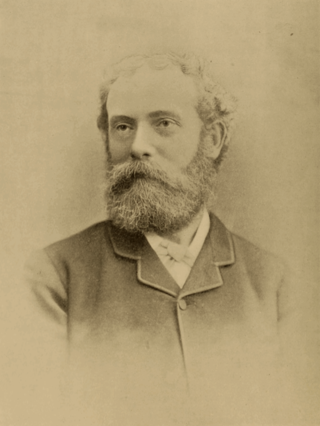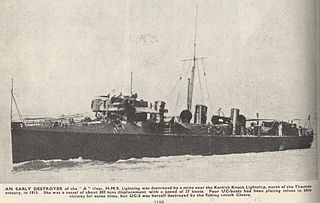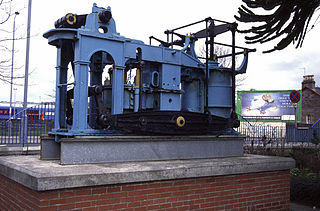
A steamship, often referred to as a steamer, is a type of steam-powered vessel, typically ocean-faring and seaworthy, that is propelled by one or more steam engines that typically move (turn) propellers or paddlewheels. The first steamships came into practical usage during the early 1800s; however, there were exceptions that came before. Steamships usually use the prefix designations of "PS" for paddle steamer or "SS" for screw steamer. As paddle steamers became less common, "SS" is assumed by many to stand for "steamship". Ships powered by internal combustion engines use a prefix such as "MV" for motor vessel, so it is not correct to use "SS" for most modern vessels.

USS Michigan was the United States Navy's first iron-hulled warship and served during the American Civil War. She was renamed USS Wolverine in 1905.

USS Oglala (ID-1255/CM-4/ARG-1) was a minelayer in the United States Navy. Commissioned as Massachusetts, she was renamed Shawmut a month later, and in 1928, was renamed after the Oglala, a sub-tribe of the Lakota, residing in the Black Hills of South Dakota.

Benjamin Franklin Isherwood was an engineering officer in the United States Navy during the early days of steam-powered warships. He served as a ship's engineer during the Mexican–American War, and after the war did experimental work with steam propulsion. Rising to the rank of rear admiral, as Engineer-in-Chief of the Navy during the Civil War, he helped to found the Navy's Bureau of Steam Engineering.

Sir John Isaac Thornycroft was an English shipbuilder, the founder of the Thornycroft shipbuilding company and member of the Thornycroft family.

Neafie, Levy & Co., commonly known as Neafie & Levy, was a Philadelphia, Pennsylvania shipbuilding and engineering firm that existed from the middle of the 19th to the beginning of the 20th century. Described as America's "first specialist marine engineers", Neafie & Levy was probably the first company in the United States to combine the building of iron ships with the manufacture of steam engines to power them. The company was also the largest supplier of screw propellers to other North American shipbuilding firms in its early years, and at its peak in the early 1870s was Philadelphia's busiest and most heavily capitalized shipbuilder.
HMS Zebra was a "Twenty-seven Knotter" destroyer of the Royal Navy, later classified as part of the A Class. Zebra was built by Thames Iron Works and launched in 1895 as the fifth Royal Navy ship to be named Zebra. Entering service in 1900, Zebra was sold for scrap in 1914.

HMS Lightning was a Janus-class destroyer of the British Royal Navy, later designated an A-class destroyer, built by Palmers and launched in 1895.

A marine steam engine is a steam engine that is used to power a ship or boat. This article deals mainly with marine steam engines of the reciprocating type, which were in use from the inception of the steamboat in the early 19th century to their last years of large-scale manufacture during World War II. Reciprocating steam engines were progressively replaced in marine applications during the 20th century by steam turbines and marine diesel engines.
The Allaire Iron Works was a leading 19th-century American marine engineering company based in New York City. Founded in 1816 by engineer and philanthropist James P. Allaire, the Allaire Works was one of the world's first companies dedicated to the construction of marine steam engines, supplying the engines for more than 50% of all the early steamships built in the United States.
The Delaware River Iron Ship Building and Engine Works, was a major late-19th-century American shipyard located on the Delaware River in Chester, Pennsylvania. It was founded by the industrialist John Roach and is often referred to by its parent company name of John Roach & Sons, or just known as the Roach shipyard. For the first fifteen years of its existence, the shipyard was by far the largest and most productive in the United States, building more tonnage of ships than its next two major competitors combined, in addition to being the U.S. Navy's largest contractor. The yard specialized in the production of large passenger freighters, but built every kind of vessel from warships to cargo ships, oil tankers, ferries, barges, tugs and yachts.

RMS Victorian was the world's first turbine-powered ocean liner. She was designed as a transatlantic liner and mail ship for Allan Line and launched in 1904.
Lawrence & Foulks was a 19th-century American shipbuilding company based in New York. Established in the early 1850s, the company built 144 vessels of all types over the course of some fifty years, but is best known for its production of high-speed wooden-hulled steamboats and steamships. Notable vessels built by the company include the record-breaking Hudson River steamboat Chauncey Vibbard, the luxury Long Island Sound steamer Commonwealth, and the fast oceangoing steamships—later U.S. Navy gunboats—Bienville and De Soto. In addition to the domestic market, the company also built ships for service as far afield as South America and China.
Lake steamers of North America include large, steam-powered non-government vessels with displacement hulls on American freshwater lakes excluding the Great Lakes. They may have served as passenger boats, freighters, mail-boats, log-boom vessels or a combination thereof. The construction of such vessels posed unique problems on water bodies located away from established dry-docks and marine railways, or connecting canals to such facilities.

SS Rochambeau was a French transatlantic ocean liner of the Compagnie Générale Transatlantique (CGT). She was launched in 1911 and scrapped in 1934. She was the first French ship to be powered by a combination of reciprocating steam engines and steam turbines.

Horace See was an American mechanical engineer, marine engineer, naval architect, inventor, and superintendent. He is known as principal naval architect at the William Cramp & Sons shipyard in Philadelphia, and as president of the American Society of Mechanical Engineers in the year 1888–89.

The Continental Iron Works was an American shipbuilding and engineering company founded in Greenpoint, Brooklyn, in 1861 by Thomas F. Rowland. It is best known for building a number of monitor warships for the United States Navy during the American Civil War, most notably the first of the type, USS Monitor. Monitor's successful neutralization of the Confederate ironclad CSS Virginia in the 1862 Battle of Hampton Roads—the world's first battle between ironclad warships—would come to heavily influence American naval strategy both during and after the war.

Messrs Robert Napier and Sons was a famous firm of Clyde shipbuilders and marine engineers at Govan, Glasgow founded by Robert Napier in 1826. It was moved to Govan for more space in 1841. His sons James and John were taken into partnership in 1853.

Edinburgh Castle was a Union-Castle Line steam ocean liner and refrigerated cargo ship that was launched in 1910 and sunk in 1945. In peacetime she was in liner service between Great Britain and South Africa.
Charles Atherton was a British scientific engineer from Calne, Wiltshire. He was appointed as Chief Engineer and Inspector of Steam Machinery at Her Majesty's Woolwich Dockyard in 1847; and a second time between 1851 and 1862. He served in the same capacity at Her Majesty's Devonport Dockyard between 1848 and 1851.














